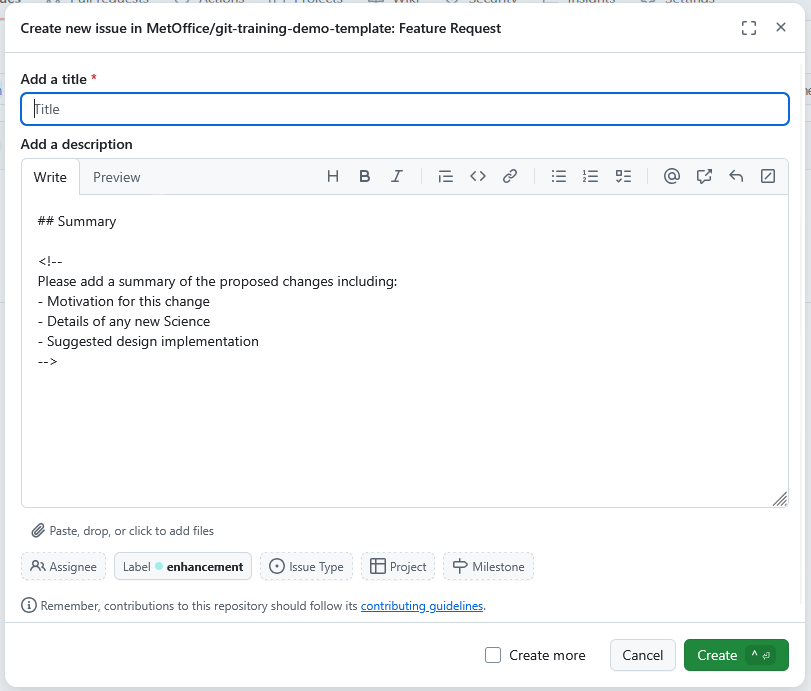Issues
Last updated on 2025-02-26 | Edit this page
Estimated time: 15 minutes
Overview
Questions
- What information should go on an Issue?
- What are Issue templates?
Objectives
- Create an Issue with the correct labels.
- Assign yourself to an Issue.
GitHub Issues (tickets) are where you plan and track work. You can
assign individuals to Issues and label them with a relevant tag such as
bug or enhancement. Before opening a new Issue
check whether there is already one open for the feature or bug by using
GitHub’s search.
Here’s some advice for writing good Issues:
- Be clear and concise, provide plenty of detail
- State the expected outcomes
- Tag relevant collaborators
- Break up large Issues into several small ones and or use checklists to track tasks in the Issue
Open an Issue on the git-training-demo repository to add
a file stating your favourite cloud type.
Navigate to the Issues tab:

This repositories Issue tab looks different to the
weather repository you worked on in the Introduction to Git
& GitHub lesson. It uses Issue
templates to provide templates for bugs and feature requests. Click
on the green Get started button next to the
Feature request option:

You can see the Issue has text in the description already. This is
from the template which provides a consistent structure to the Issues on
this repo. The template has also added the enhancement
label for you.
Add in a clear title such as “Add mo-fitzroy’s favourite cloud type”, replace ‘mo-fitzroy’ with your GitHub username. Click Submit new issue.
It’s a good idea to remind learners that images can be dropped straight into the Issue description. An image of a cloud should do!
Projects, milestones, and labels
Your instructor has set up a Project and some custom milestones for you to add to your Issue.
- Labels help you classify Issues and PRs.
- Milestones group Issues and PRs, tracking their progress towards a common milestone automatically.
- Projects are a tool for planning and tracking work via GitHub. Multiple repositories can be linked to a single project. Projects can have multiple views depending on your needs; some have kanban boards and gantt charts, others separate out an individual colleagues Issues to avoid clutter.
Assign yourself, a project, and a milestone to your Issue
On the right hand side of the Issue you can:
- Assign yourself to the Issue so that others know you are working on it.
- Add the Issue to a Project by clicking on the cog next to the Projects section. (If you don’t see a project related to the training you might not have been granted permissions, ask your instructors for help)
- Assign the Issue to a milestone.
Key Points
- Issues are used to track and plan work.
- Issue templates provide template text for the first comment for new Issues of various types. They can auto-label Issues and encourage collaborators to give plenty of detail.
